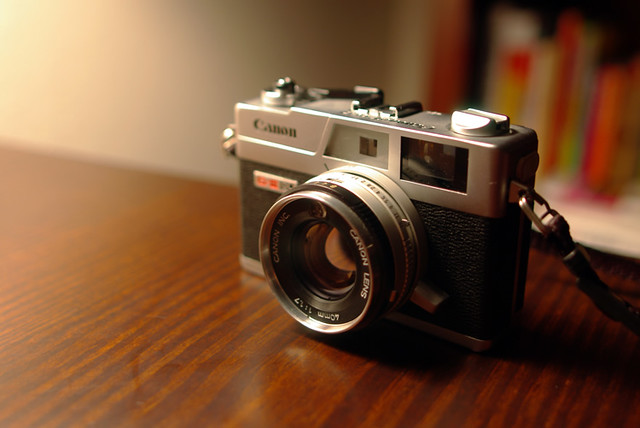A cult camera. An icon of the 70s'
 |
| CC Image courtesy of Lozit on Wikimedia Commons |
In recent years, the Canonet G-III QL17 had proven to be a hit amongst hipsters and Canon fanboys alike, but back in the days, the G-III was one of the bestsellers of Canon since Canon was around! First off, for those who are new to the camera, the Canonet is the series of 35mm compact RF's, the G-III is the third generation of the Canonet series, QL is what Canon regarded as the 'Quick-Load' system which semi-automatically loads the film into the camera, and 17 is it's widest aperture at f/1.7.
Throughout the years, Canon had been pumping tons of Canonet's ranging from the QL17, which is the series' top-dog camera, to the QL19 and the 28. Today, I will be talking about what we consider as the best compact 35mm Rangefinder of all time; the G-III QL17.
Canon made it's first debut of the G-III back in 1972 with a staggering 1.2 million sales through to 1982, making the G-III probably one of the most successful camera in it's time. The specifications on this camera even surpasses the Leica CL albeit in a much cheaper price; just imagine a Sony RX1 with a 1.7 lens for 200 bucks? Incredible.
The Canonet G-III QL17 as said before is a compact 35mm rangefinder which boasts some amazing specs including a fast 40mm 1.7 lens, which is wide enough for some landscape shots, and long enough to do some portrait work on the streets with the closest focusing distance of 0.8 meters or 2.6 feet. To top that off, the lens is combined with automatic exposure and manual over-ride, a killer feature back in those days.
The rangefinder on the G-III is surprisingly bright but has a slight blue tint to it; a typical feature in early compact rangefinders to improve contrast, but I suppose it would not make much difference if you shoot black and white. The finder sports a 0.6x magnification, which goes extremely well with the 40mm lens and a frameline that compensates parallax error, which is very rare amongst cameras of the same genre.
As said before, the G-III sports a 'Quick-Load' feature which allows you to easily load the film by simply pulling the film leader over the red mark located near the take-up spool and close the back door to advance the film. If the film is loaded correctly, the red bars in the film counter window would move.
The Canonet G-III QL17 as said before is a compact 35mm rangefinder which boasts some amazing specs including a fast 40mm 1.7 lens, which is wide enough for some landscape shots, and long enough to do some portrait work on the streets with the closest focusing distance of 0.8 meters or 2.6 feet. To top that off, the lens is combined with automatic exposure and manual over-ride, a killer feature back in those days.
The rangefinder on the G-III is surprisingly bright but has a slight blue tint to it; a typical feature in early compact rangefinders to improve contrast, but I suppose it would not make much difference if you shoot black and white. The finder sports a 0.6x magnification, which goes extremely well with the 40mm lens and a frameline that compensates parallax error, which is very rare amongst cameras of the same genre.
As said before, the G-III sports a 'Quick-Load' feature which allows you to easily load the film by simply pulling the film leader over the red mark located near the take-up spool and close the back door to advance the film. If the film is loaded correctly, the red bars in the film counter window would move.
 |
| CC Image courtesy of rustman on Flickr |
Flash
work on this camera is possible with the Canolite D Flash which is
made particularly for the Canonet series. Once the camera is set to
'A' mode, the flash will operate automatically in correlation with
the readings from the light meter in front of the lens.
For
those who want to snap away with this camera can easily use shutter
priority or automatic exposure, but for those who are interested in
getting the best out of this camera can use manual-override, but
without the metering. Flash can also be used with this camera with
flash sync at all speeds up to 1/500th of a second, albeit without
TTL operation.
A
side note to the ones who are interested in purchasing one of these cameras - Unfortunately, the batteries used in the Canonet, the
mercury 625 batteries are now outlawed by many countries and are
probably out of date if you could possibly find one. But you do have
an option to use either the 1.35V alkaline batteries or the highly
recommended Zinc/Air 1.35V, which you could easily find nowadays in
electronics shops.
Despite
the letdown on the battery, the Canonet is a very well functioned
camera. The features on this camera is way ahead of it's time, yet
with a price tag less 200 dollars. The lens is extremely sharp
producing almost identical images to that of the Leica CL with a 40mm
lens. The body is nice to the touch and well balanced. So those who
are looking for a good 35mm compact RF you could take with you
everyday, stop your search now because your answer is here, the Canon
Canonet G-III QL17.
*Note
- the black version of this camera is very rare nowadays and is an
absolute beauty; so to all collectors, find one and buy it straight
away. The G-III will never disappoint.

No comments:
Post a Comment